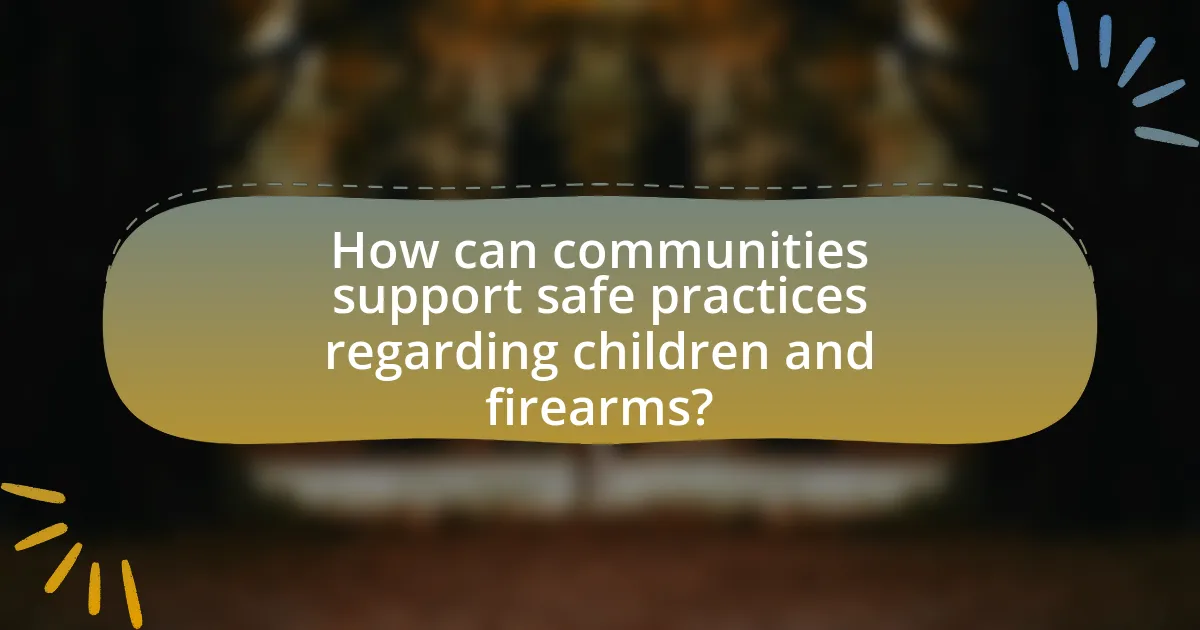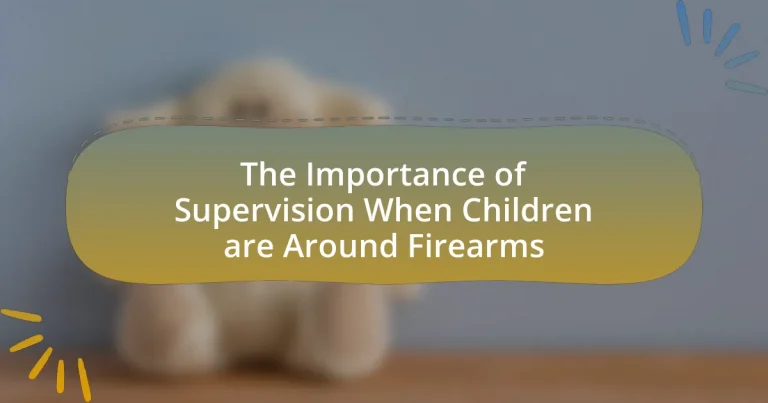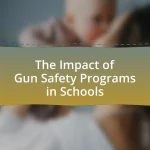The article emphasizes the critical importance of supervision when children are around firearms, highlighting that active oversight significantly reduces the risk of accidental shootings and injuries. It presents alarming statistics, noting that over 1,300 children in the United States are killed by firearms each year, often due to unsupervised access. The article outlines the risks associated with children and firearms, including accidental discharges and psychological trauma, and discusses best practices for supervision, such as secure storage and education on firearm safety. It also explores the role of adult presence in preventing accidents and the importance of community support in promoting safe practices regarding firearms.

Why is Supervision Crucial When Children are Around Firearms?
Supervision is crucial when children are around firearms because it significantly reduces the risk of accidental shootings and injuries. According to the Centers for Disease Control and Prevention (CDC), unintentional firearm injuries are a leading cause of death among children, with over 500 fatalities annually in the United States. Active supervision ensures that adults can intervene immediately if a child accesses a firearm, preventing potential tragedies. Furthermore, studies indicate that children are naturally curious and may not understand the dangers associated with firearms, making adult oversight essential for their safety.
What are the risks associated with children and firearms?
The risks associated with children and firearms include accidental shootings, increased likelihood of injury or death, and psychological trauma. Statistics indicate that in the United States, approximately 1,300 children aged 0-17 are killed by firearms each year, with many of these incidents occurring due to unsupervised access to firearms. Furthermore, studies show that children who are exposed to firearms without proper supervision are more likely to engage in unsafe behaviors, such as handling guns improperly, which can lead to tragic outcomes. The presence of firearms in homes with children significantly raises the risk of unintentional injuries, emphasizing the critical need for supervision and secure storage of firearms to mitigate these dangers.
How do accidental discharges occur in the presence of children?
Accidental discharges occur in the presence of children primarily due to improper storage and handling of firearms. Children may access firearms that are not securely stored, leading to unintentional trigger pulls. According to the National Safety Council, approximately 1,300 children die each year from gun-related incidents, many of which are attributed to accidental discharges when children find loaded firearms. Additionally, lack of supervision increases the risk, as children may not understand the dangers associated with firearms, leading to mishandling.
What statistics highlight the dangers of unsupervised children with firearms?
Unsupervised children with firearms face significant dangers, as evidenced by statistics indicating that nearly 1,300 children aged 0-17 are killed by firearms each year in the United States. Furthermore, a study published in the journal “Pediatrics” found that approximately 1 in 3 homes with children have firearms, and nearly 1 in 2 of those firearms are stored unlocked. This lack of supervision and secure storage contributes to accidental shootings, with the American Academy of Pediatrics reporting that unintentional firearm injuries are a leading cause of death among children. These statistics underscore the critical need for supervision and safe storage practices to prevent tragic outcomes.
How does supervision mitigate these risks?
Supervision mitigates risks associated with children being around firearms by ensuring constant oversight and immediate intervention. When adults actively monitor children’s interactions with firearms, they can prevent unsafe behaviors, such as handling or playing with guns. Research indicates that homes with responsible adult supervision significantly reduce the likelihood of firearm-related accidents involving children. For instance, a study published in the Journal of Pediatrics found that proper supervision decreased the risk of unintentional firearm injuries by up to 80%. This demonstrates that vigilant supervision is a critical factor in safeguarding children from potential dangers posed by firearms.
What role does adult presence play in preventing firearm accidents?
Adult presence significantly reduces the likelihood of firearm accidents by providing supervision and guidance. Research indicates that children are less likely to engage with firearms when an adult is present, as adults can enforce safety rules and educate children about the dangers associated with guns. A study published in the journal “Pediatrics” found that the presence of an adult during interactions with firearms decreased the risk of unintentional shootings among children by over 50%. This highlights the critical role adults play in ensuring safe environments around firearms, ultimately preventing tragic accidents.
How can supervision influence children’s understanding of firearm safety?
Supervision significantly enhances children’s understanding of firearm safety by providing direct guidance and modeling safe behaviors. When adults actively supervise children around firearms, they can teach critical safety rules, such as treating every gun as if it is loaded and keeping firearms out of reach. Research indicates that children who receive consistent supervision and education about firearm safety are less likely to engage in risky behaviors, as demonstrated by a study published in the Journal of Pediatrics, which found that supervised children had a 70% lower risk of firearm-related accidents. This direct involvement helps children internalize safety practices and fosters a culture of responsibility regarding firearms.

What are the best practices for supervising children around firearms?
The best practices for supervising children around firearms include ensuring that firearms are stored securely, educating children about gun safety, and maintaining constant supervision when firearms are present. Secure storage involves using gun safes or locked cabinets to prevent unauthorized access, as studies show that 73% of children who live in homes with firearms report knowing where the guns are stored. Educating children about the dangers of firearms and the importance of not touching them without adult supervision is crucial; research indicates that children who receive proper education are less likely to engage in unsafe behaviors. Finally, constant supervision means that adults should always be present when children are near firearms, as this significantly reduces the risk of accidents.
What guidelines should adults follow when supervising children with firearms?
Adults supervising children with firearms should adhere to strict safety guidelines to ensure the well-being of both the children and others. First, adults must maintain constant supervision, ensuring that children are never left alone with firearms. This is crucial as studies indicate that unsupervised access significantly increases the risk of accidental discharges and injuries.
Second, adults should educate children about firearm safety, including the importance of treating every firearm as if it is loaded, keeping the muzzle pointed in a safe direction, and understanding the basic mechanics of the firearm. Research from the National Shooting Sports Foundation shows that proper education can reduce the likelihood of accidents.
Third, adults should securely store firearms in locked cabinets or safes, with ammunition stored separately, to prevent unauthorized access. The Centers for Disease Control and Prevention reports that safe storage practices are effective in reducing firearm-related injuries among children.
Lastly, adults should model responsible behavior by demonstrating safe handling practices and discussing the potential dangers associated with firearms. This approach reinforces the lessons taught and helps children develop a responsible attitude towards firearms.
How can adults create a safe environment for children around firearms?
Adults can create a safe environment for children around firearms by implementing strict safety protocols and ensuring constant supervision. This includes securely storing firearms in locked cabinets or safes, using trigger locks, and keeping ammunition stored separately. According to the National Safety Council, proper storage can reduce the risk of accidental shootings by up to 73%. Additionally, adults should educate children about the dangers of firearms, emphasizing the importance of not touching them without adult supervision. Research from the American Academy of Pediatrics indicates that children who receive firearm safety education are less likely to engage in unsafe behaviors around guns. Regularly discussing firearm safety and modeling responsible behavior further reinforces a culture of safety.
What specific actions should adults take to ensure effective supervision?
Adults should actively monitor children’s interactions with firearms by maintaining close physical proximity and establishing clear rules regarding firearm safety. Effective supervision involves ensuring that firearms are stored securely, preferably in locked safes, and that children are educated about the dangers of firearms. Research indicates that secure storage reduces the risk of accidental shootings; for instance, a study published in the Journal of Trauma found that safe storage practices can decrease firearm-related injuries among children by up to 85%. Additionally, adults should engage in open conversations about firearm safety, reinforcing the importance of not touching firearms without adult permission. This proactive approach fosters a culture of safety and awareness, significantly mitigating risks associated with children and firearms.
What educational approaches can enhance supervision effectiveness?
Educational approaches that can enhance supervision effectiveness include training programs focused on firearm safety, parental education initiatives, and community workshops. Training programs that emphasize the importance of secure firearm storage and the potential dangers of firearms can significantly improve adults’ awareness and supervision skills. For instance, research by the American Academy of Pediatrics indicates that parents who participate in firearm safety training are more likely to implement safe storage practices, thereby reducing children’s access to firearms. Additionally, parental education initiatives that provide resources and strategies for discussing firearm safety with children can foster a proactive approach to supervision. Community workshops that engage families in discussions about the risks associated with firearms and the importance of vigilant supervision can further reinforce these educational efforts.
How can adults teach children about firearm safety while supervising?
Adults can teach children about firearm safety while supervising by engaging in direct, hands-on education that emphasizes the importance of respect and caution around firearms. This can include demonstrating safe handling practices, such as always treating a firearm as if it is loaded, keeping the muzzle pointed in a safe direction, and ensuring that the safety is engaged when not in use.
Additionally, adults should encourage open discussions about firearms, allowing children to ask questions and express their thoughts, which reinforces understanding and retention of safety principles. According to the National Shooting Sports Foundation, structured education programs that involve both theoretical knowledge and practical demonstrations significantly reduce the risk of firearm accidents among children.
What resources are available for educating families about firearm safety?
Resources available for educating families about firearm safety include the National Rifle Association’s Eddie Eagle GunSafe Program, which teaches children about gun safety through engaging materials. Additionally, the American Academy of Pediatrics provides guidelines and resources for parents on safe firearm storage and handling. The Centers for Disease Control and Prevention also offers educational materials focused on preventing firearm injuries among children. These organizations provide evidence-based information and practical strategies to enhance safety around firearms in family settings.

How can communities support safe practices regarding children and firearms?
Communities can support safe practices regarding children and firearms by implementing educational programs that emphasize firearm safety and responsible ownership. These programs can include workshops for parents and guardians that teach safe storage practices, such as using gun safes and trigger locks, which are proven to reduce accidental shootings among children. According to the American Academy of Pediatrics, secure storage of firearms can decrease the risk of child access to guns, thereby preventing tragic incidents. Additionally, communities can organize events that promote awareness about the dangers of firearms in homes with children, encouraging open discussions among families about safety measures. By fostering a culture of safety and responsibility, communities can significantly mitigate the risks associated with children and firearms.
What community programs exist to promote firearm safety for families?
Community programs that promote firearm safety for families include the Eddie Eagle GunSafe Program, which teaches children about gun safety through educational materials and resources. Additionally, the National Shooting Sports Foundation offers the “Project ChildSafe” initiative, providing free gun locks and safety education to families. These programs are designed to reduce accidental shootings and promote responsible firearm ownership, evidenced by statistics showing a decrease in firearm-related accidents in communities that implement such educational initiatives.
How can local organizations contribute to firearm safety education?
Local organizations can contribute to firearm safety education by providing community workshops and training sessions focused on safe firearm handling and storage practices. These organizations can leverage their local presence to reach families and educate them on the importance of supervision when children are around firearms, emphasizing that proper education can significantly reduce accidental shootings. Research indicates that communities with active firearm safety programs see a decrease in firearm-related incidents, highlighting the effectiveness of local initiatives in promoting safety awareness.
What role do schools play in educating children about firearms?
Schools play a crucial role in educating children about firearms by providing safety education and awareness programs. These programs often include lessons on the dangers of firearms, the importance of not touching guns, and how to seek help from adults if they encounter a firearm. Research indicates that comprehensive firearm safety education in schools can significantly reduce the likelihood of accidental shootings among children. For instance, a study published in the Journal of School Health found that students who participated in firearm safety programs demonstrated increased knowledge and safer behaviors regarding firearms.
What practical tips can families implement for safe supervision?
Families can implement several practical tips for safe supervision around firearms, including establishing clear rules about firearm access, ensuring firearms are stored unloaded and locked in a secure location, and using gun safes or lockboxes. Additionally, families should educate children about the dangers of firearms and encourage open communication regarding any questions or concerns. Regularly reviewing safety practices and conducting supervised firearm handling sessions can reinforce responsible behavior. According to the National Shooting Sports Foundation, proper storage and education significantly reduce the risk of accidental shootings involving children.
How can families establish rules for firearm access in the home?
Families can establish rules for firearm access in the home by creating clear guidelines that prioritize safety and restrict access to firearms. These rules should include securing firearms in locked storage, ensuring that only responsible adults have access, and implementing a system for regular communication about firearm safety among family members. Research indicates that homes with locked firearms experience significantly lower rates of unintentional shootings and suicides among children, highlighting the effectiveness of such measures in preventing tragedies.
What strategies can parents use to discuss firearms with their children?
Parents can use open communication, education about firearm safety, and role-playing scenarios as strategies to discuss firearms with their children. Open communication allows parents to create a safe space for children to ask questions and express their feelings about firearms. Educating children about firearm safety, including the importance of not touching firearms without adult supervision, reinforces responsible behavior. Role-playing scenarios can help children practice what to do if they encounter a firearm, ensuring they understand the seriousness of the situation. These strategies are effective in promoting awareness and safety, as studies show that children who receive proper education about firearms are less likely to engage in risky behaviors.


